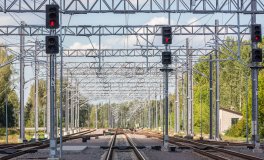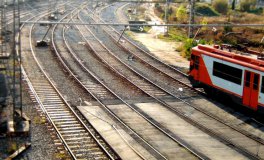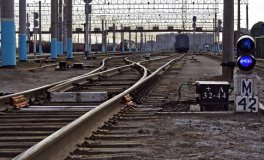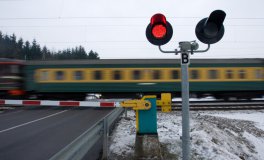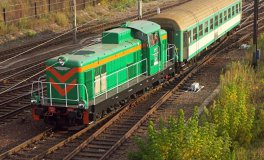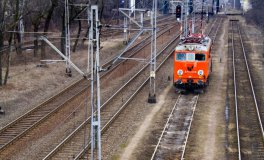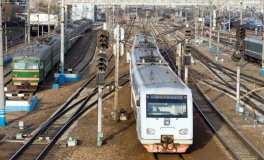
Railways solutions
The first microprocessor-based railway traffic control system in the Baltic States was installed by FIMA and its partners.
About
Solutions
- Railway overhead contact line
- Traffic control centralisation systems
- Points and signals interlocking systems
- Automatic and semi-automatic line block system
- Level crossing signalling systems
- Locomotive control automation systems
- Automatic rolling-stock control systems
- Electric point heating
- Axle counting systems
- Technological loudspeaker communication and staff warning system
Related projects
-
 Modernisation of signalling system on Liepaja Railway Station with reconstruction of Railway tracks
Modernisation of signalling system on Liepaja Railway Station with reconstruction of Railway tracks -
 Modernising East–West railway corridor
Modernising East–West railway corridor -
 Modernisation of traffic control, telecommunications and power supply systems on Lithuanian Railways’ IX D corridor
Modernisation of traffic control, telecommunications and power supply systems on Lithuanian Railways’ IX D corridor -
 Modernisation of telecommunication systems on Kaišiadorys–Kybartai railway section
Modernisation of telecommunication systems on Kaišiadorys–Kybartai railway section -
 Integrated project to install engineering systems in the Stasylos railway border inspection post
Integrated project to install engineering systems in the Stasylos railway border inspection post -
 Engineering Solutions in Kaunas rail tunnel
Engineering Solutions in Kaunas rail tunnel
Testimonials
-
You can entrust the installation of complex engineering systems to FIMA experts.
-
The company proved to be a reliable partner which is able to manage and implement complex projects and carry out non-standard works.
Contact
-
+370 5 2363535
-
Railways solutions
We have 20 years of experience of designing and installing railway solutions. We are the leading system integrator for the modernisation of railway traffic control systems in the Baltic region, with a constant focus on the most up-to-date solutions.
FIMA is the only company in the Baltic region with complete experience of installing engineering systems in the railway sector, including traffic control systems, power supply infrastructure, telecommunications, security solutions, and passenger information systems. Our ability to integrate existing systems with new microprocessor-based control systems marks us out, ensuring high rail traffic safety standards and making the work of rail staff easier.
FIMA cooperates with major international companies offering the best products in the area. Our employees are certified railway system design and installation experts.
More information: Railway Solutions Brochure.
-
Railway overhead contact line
We implement railway electrification projects, taking care of every phase of catenary network deployment, starting with the design and assembly of metal structures with clamps and ending with the installation of bronze or copper wires. We use our own carrying cable and catenary line installation machine, which can be operated on either a Russian-gauge and European-gauge platform.
-
Traffic control centralisation systems
We integrate individual railway station centralisation systems into a single traffic control centralisation system, thereby creating a single management point. A traffic control centralisation system is a set of automatic line blocking and interlocking system to manage all types of points and signals from a single control centre.
By combining individual stations’ centralisation systems into a single traffic control system and creating a single command post for rail traffic control, we are able to reduce costs, resolve traffic organisation issues and ensure a more cost-effective use of rail infrastructure.
-
Points and signals interlocking systems
We design and install relay, blocking-relay, relay-microprocessor and microprocessor based interlocking systems. These control and monitor the status of points, signals and the position of rolling stock from a single control post, removing the possibility of human error when organising rail traffic. We use safe, tested and certified technical solutions which guarantee the highest level of safety and reliability.
The construction or upgrade of such systems can result in substantially lower rail traffic management costs, increased safety, simplified traffic control and significant increases in train speed and traffic intensity.
All the systems have been tested and certified. Microprocessor interlocking systems comply with the highest safety requirements (SIL 4) under CENELEC classification and adhere to the fail-safe principle.
-
Automatic and semi-automatic line block system
We design and install relay and microprocessor based automatic and semi-automatic line block systems. These regulate railway traffic between neighbouring stations, based on signals sent by track occupancy equipment and light equipment between stations.
An automatic line block system ensures higher rail traffic intensity as well as safer and more efficient use of railways. With a system in place, we can increase rail capacity by 25 per cent, thereby eliminating the need to build second tracks between stations. Microprocessor based automatic line block system with centralised control equipment may reduce system maintenance costs by as much as 60 per cent.
For the control of rail occupancy, electric railway chains or axle counters can be used.
-
Level crossing signalling systems
To ensure level crossing safety, FIMA supplies and installs relay and microprocessor-based level crossing signalling systems warning vehicle drivers of approaching trains. As an additional safety measure, we install automatic or semi-automatic level crossing blocks or barriers. A level crossing signalling system can operate autonomously or can be integrated into a traffic control system.
With level crossing signalling systems sited where rails and roads intersect, the possibility of collisions drops significantly.
-
Locomotive control automation systems
We replace electromechanical automatic signalling systems in locomotives with electronic systems. We build ERTMS equipment complying with European Union railway standards.
These state-of-the-art systems reduce operational costs, increase train traction and stopping efficiency, simplify train control, enable management of the parameters necessary for safe train control and provide detailed information about the driver’s actions and operation of mechanisms.
-
Automatic rolling-stock control systems
We offer modern hot-box, halted wheel and wheel geometry defect detection systems that work while rolling-stock is in motion. When installed, these systems can inspect the hot boxes of locomotives and their carriages when in motion while rolling-stock geometry defect detection systems inspect the geometry of rolling-stock.
The installation of these systems results in lower rolling-stock and railway infrastructure maintenance costs, a smaller number of rolling-stock accidents and damage caused to railway infrastructure.
-
Electric point heating
We offer an electric point heating system designed and manufactured by our experts in response to the needs of Lithuanian railways. The system, which is specially adapted for the client, has been tested and certified by the Certification Centre of Electrotechnic Products. Over the last decade, FIMA has installed electric point heating on more than 300 points.
Our system ensures uninterruptible and safe railway operation even under the most unfavourable weather conditions. Electric point heating switches on automatically upon receiving data from a meteorological centre and rail temperature sensors.
-
Technological loudspeaker communication and staff warning system
FIMA builds announcement systems in stations, switch yards and on platforms enabling both manual and automatic transmission of instructions to the station or its area. Announcements are transmitted through a communications panel or special device by the person on duty at the station or by special generators of automatic announcements. Loudspeakers are installed in the station in order to transmit instructions regarding train traffic and manoeuvring as well as to help the employees working in the switch yards to contact with the operator at the station.
When installing communication systems, we replace analogue systems with modern digital switching and fibre-optic communication systems, thereby reducing operating costs and simplifying the overall control of the system.


